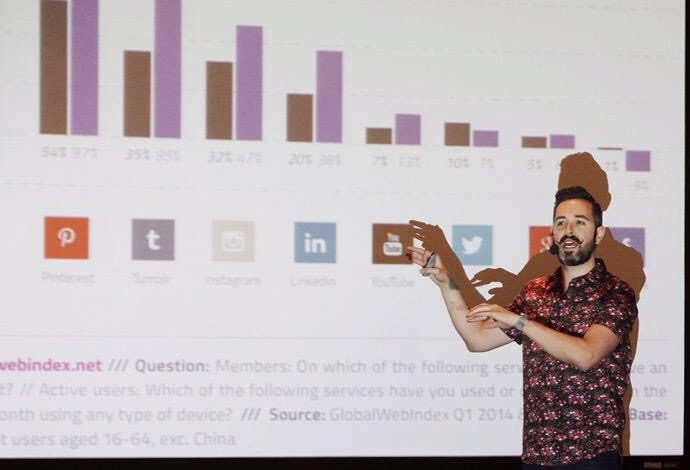Posts Tagged "Social commerce benefits"
Articles
- Best Marketing Conference Sponsorship
- What Does it Mean to Be an Exhibitor at a Conference?
- What Is the Biggest Social Media Conference?
- What Is an Innovation Conference?
- What Is a Typical B2B Event?
- What Are the Cloud Technology Events in 2025?
- Marketing Event Volunteer Opportunities: A Comprehensive Guide
- Digital Marketing Event Volunteer Opportunities Near Me
- What Does a Volunteer Do at a Conference?
- Is DigiMarCon Worth It?
- Is DigiMarCon Good?
- What is the Biggest Marketing Forum?
- What are Digital Marketing Conferences?
- Marketing Conference Exhibiting: Your Guide to Success
- Digital Summit Comparison: A Closer Look at DigiMarCon
- Digital Marketing Conference
- Digital Marketing Events: Your Guide to Success in 2025
- Marketing Conferences: Unlocking Your Business Potential in 2025
- What Is The Future of Digital Marketing in 2030?
- B2B Event Marketing Strategy: Unlocking Success For Your Business
- Why B2B Event Marketing?
- What Should a B2B Marketing Strategy Include?
- Top Marketing Conferences for 2025
- What Is the Future of Marketing in 2025?
Digital Marketing Conferences
- NORTH AMERICA
- DigiMarCon Cruise
(New Orleans, LA, USA) - DigiMarCon West
(Los Angeles, CA, USA) - DigiMarCon Northwest
(Seattle, WA, USA) - DigiMarCon Canada West
(Vancouver, BC, USA) - DigiMarCon Canada
(Toronto, ON, Canada) - DigiMarCon Canada East
(Montreal, QC, Canada) - DigiMarCon Florida
(Orlando, FL, USA) - DigiMarCon Gulf Coast
(Houston, TX, USA) - DigiMarCon Southern California
(San Diego, CA, USA) - DigiMarCon Midwest
(Chicago, IL, USA) - DigiMarCon Mid-South
(Nashville, TN, USA) - DigiMarCon Great Lakes
(Detroit, MI, USA) - DigiMarCon North
(Minneapolis, MN, USA) - DigiMarCon Central
(Kansas City, MO, USA) - DigiMarCon Texas
(Dallas, TX, USA) - DigiMarCon New England
(Boston, MA, USA) - DigiMarCon Mid-Atlantic
(Philadelphia, PA, USA) - DigiMarCon South Florida
(Miami, FL, USA) - DigiMarCon Southeast
(Atlanta, GA, USA) - DigiMarCon Central Florida
(Tampa, FL, USA) - DigiMarCon East
(New York, NY, USA) - DigiMarCon South Atlantic
(Charlotte, NC, USA) - DigiMarCon America
(Washington, D.C. USA) - DigiMarCon Northern California
(San Francisco, CA, USA) - DigiMarCon Rocky Mountains
(Denver, CO, USA) - DigiMarCon South
(San Antonio, TX, USA) - DigiMarCon Silicon Valley
(San Jose, CA, USA) - DigiMarCon Orange County
(Anaheim, CA, USA) - DigiMarCon Southwest
(Phoenix, AZ, USA) - DigiMarCon World
(Las Vegas, NV, USA)
- DigiMarCon Cruise
- LATIN AMERICA
- EUROPE
- MIDDLE EAST
- AFRICA
- ASIA PACIFIC
- DigiMarCon Hawaii & Pacific
(Honolulu, HI, USA) - DigiMarCon Asia & Japan
(Tokyo, Japan) - DigiMarCon New Zealand
(Auckland, New Zealand) - DigiMarCon Australia
(Sydney, Australia) - DigiMarCon Oceania
(Melbourne, Australia) - DigiMarCon Southeast Asia
(Singapore) - DigiMarCon India
(New Delhi, India) - DigiMarCon North Asia & China
(Shanghai, China)
- DigiMarCon Hawaii & Pacific
- VIRTUAL
Digital Marketing Blog
- Unlock Website Traffic Growth: 10 Proven Hacks to Try September 16, 2025
- Sponsorship Opportunities at DigiMarCon 2025 – Join Us Now September 16, 2025
- Sponsorship Opportunities at DigiMarCon 2025 – Join Us Now September 16, 2025
- Mastering Video Marketing: Essential Tips to Boost Your Business September 15, 2025

































Discover the Benefits of Social Commerce
In today’s digital age, how we shop is changing a lot. Social commerce is leading this change. It mixes social media and e-commerce for a smooth shopping experience.
Imagine buying things right from your favorite social media sites. No need to go to another website. This is what social shopping offers, making the digital marketplace exciting.
More people are using social media to find and get product tips. This gives businesses a chance to connect with their audience in a fun and interactive way.
Key Takeaways
The Rise of Social Commerce
Social commerce has changed the digital retail world. It’s how businesses talk to customers now. Social media and e-commerce together have made buying things online easier and more fun.
Social media marketing is key here. Sites like Instagram, Facebook, and Pinterest help people find and buy products. They let businesses show off their stuff in a way that feels personal and fun, building a community around their brand.
Influencer commerce has also grown a lot. Influencers, with their big followings and special knowledge, help brands reach more people. Working with influencers makes buying things feel more real and trustworthy, helping businesses sell more and get noticed.
The Evolution of Social Shopping
Social shopping has changed the game for online stores and shoppers. Social media’s growing power makes it key for e-commerce. It lets businesses connect with customers in a more personal and fun way.
This mix of social media’s interactivity and online shopping’s ease lets people find, check out, and buy products right on their favorite social sites. This blend has changed how businesses sell online.
Key Statistics and Growth Projections
Social commerce sales have grown a lot, with more growth expected. For example, many online shoppers have bought things on social media. This shows social shopping’s big potential.
What’s driving this growth? More people using mobiles, the rise of influencer marketing, and better shopping on social media. Features like shoppable posts and live streams make shopping more fun.
Key Benefits of Social Commerce for Businesses
Businesses are using social commerce to improve customer experience and boost sales. They add e-commerce features to social media. This way, they can reach more people and offer a better shopping experience.
The main advantages of social commerce for businesses are:
Case Studies of Successful Implementations
Many businesses have seen great success with social commerce. For example, a fashion brand used Instagram Shopping to tag products in their posts. This led to a big increase in sales.
Another company, in the beauty industry, used Facebook’s e-commerce tools. They created a fun shopping experience. This improved customer engagement and loyalty.
These examples show how social commerce can change the digital marketplace. Businesses that use new social commerce strategies can stay ahead. They can make the most of the growing online shopping trend.
In summary, social commerce is a great way for businesses to connect with their audience. It helps with both engagement and sales. As the digital world keeps changing, using social commerce is key for businesses to succeed in the ever-competitive digital marketplace.
Popular Social Commerce Platforms
Social commerce platforms are changing how businesses talk to customers online. They help businesses show off their brand, connect with people, and make sales.
Instagram, Facebook, and Pinterest are top choices for businesses. Each has special features for different needs. Instagram is great for businesses with a strong visual style. Facebook is best for reaching lots of people.
To get the most out of these platforms, businesses should follow specific tips. On Instagram, use great photos and influencer commerce to get more people talking. On Facebook, use ads to find the right people and make interesting content.
By knowing what each platform offers and using the right strategies, businesses can improve their social media marketing. This leads to more sales through social commerce.
Integrating Social Commerce into Your Digital Marketing Strategy
Adding social commerce to your marketing plan is key to staying ahead in today’s digital world. More and more people are shopping on social media. So, businesses need to adjust their strategies to keep up.
To make social commerce work, businesses should link it to their main marketing goals. They need to know who they’re targeting, pick the right social media, and create content that speaks to their audience.
E-commerce integration is vital for a good social commerce plan. By linking e-commerce to social media, businesses make shopping easier. This lets customers buy products right from the platform.
To see how well social commerce is doing, businesses should watch important metrics like conversion rates and sales from social media. By looking at these numbers, they can improve their social commerce plans for better results.
By adding social commerce to their digital marketing, businesses can boost their online presence and sales. As the digital world keeps changing, being ahead with social commerce is key for lasting success.
The Psychology Behind Social Shopping Experience
More and more people are using social media to shop. It’s important to know why this happens. The social shopping experience is influenced by many factors that affect how we buy things.
Social proof is a big factor in social shopping. Seeing others buy something makes us more likely to buy it too. This is why customer reviews and influencer marketing are so powerful.
Businesses can make the online community selling better by understanding these factors. They can use engaging content, encourage community interaction, and personalize shopping experiences. This can boost both engagement and sales.
The psychology of social shopping is complex. But by diving deeper into it, businesses can stay competitive in the world of social commerce.
Leveraging Influencer Commerce
Social media keeps growing, and influencer commerce is key in digital marketing. Influencers have big followings and are trusted. They help brands connect with customers in real and fun ways.
Choosing the right influencer is important. Businesses must decide between micro-influencers and macro-influencers. Each has its own benefits.
Micro vs. Macro Influencer Strategies
Micro-influencers have 1,000 to 100,000 followers. They have higher engagement rates and are seen as more real and reliable. They’re great for specific marketing or targeting certain groups.
Macro-influencers have over 100,000 followers. They help with broader brand awareness. They’re good for big campaigns to reach more people.
Choosing between micro and macro influencers depends on the marketing objectives. For example, a new product might use a macro-influencer. But, a specific community might be better with a micro-influencer.
A good influencer strategy might use both micro and macro influencers. This way, businesses can meet their social media marketing goals better. Knowing the strengths of each influencer type helps in using influencer commerce well.
Building Online Community Selling
Online communities are key in social commerce. They let businesses talk to customers and build loyalty.
To build an online community, you need a space for customers to talk to each other and the brand. You can use social media, forums, and special tools for this.
Key benefits of online community selling include:
By making customers feel part of a community, businesses can get them to buy more and tell others about it. Effective community management is key to this.
To make the most of online communities, businesses must listen to their customers. They should answer their questions and keep giving value. This way, they can build a loyal customer base that helps their business grow over time.
E-commerce Integration for Social Platforms
E-commerce integration is changing how businesses work on social media. It makes shopping easy and smooth. Now, businesses can tag products in their posts and stories. This lets customers buy without leaving the platform.
When adding e-commerce to social media, there are technical things to think about. Businesses must pick the right e-commerce platform that works with their social media. Popular e-commerce platforms like Shopify and WooCommerce have tools for social media integration.
Businesses also need to think about how easy it is for users to shop. They should make sure the checkout process is simple and that product info is easy to find. Using APIs and developer tools from social media platforms can help make this integration smooth.
By choosing the right tools and understanding the technical side, businesses can add e-commerce to their social media plans. This boosts their social commerce capabilities and helps them reach more people.
Transforming the Digital Marketplace Through Social Commerce
The digital marketplace is changing fast, thanks to social commerce. Social media is now key to online shopping. Social commerce is not just about selling products; it’s about creating an immersive experience that engages consumers and fosters brand loyalty.
This change brings both chances and hurdles for businesses. Social commerce lets companies reach their audience better, using influencers and content from users. But, it also means businesses must be quick to meet consumer needs, keeping up with the digital world.
Some key aspects of this transformation include:
As social commerce grows, businesses must be ready to change and grow. By using social media and e-commerce, companies can offer a smooth shopping experience. The future of digital commerce is here, and it’s social.
Overcoming Social Commerce Challenges
The rise of social commerce has brought new challenges for businesses. Companies must tackle issues that affect their success and reputation.
Regulatory Considerations
Complying with laws is a big challenge in social commerce. Businesses need to follow rules on consumer protection, data privacy, and advertising. Not following these rules can lead to big penalties and harm a company’s image.
To deal with these rules, businesses should:
By tackling these challenges, businesses can use social commerce to find new customers and grow. Understanding and following rules is crucial for building trust and lasting success in social commerce.
Conclusion
Social commerce is now key for businesses to grow and connect with customers. It lets companies create engaging brand experiences. This boosts sales and builds loyalty.
Adding e-commerce to social media has changed how we shop online. Social commerce brings many benefits, like better customer insights and easier shopping.
To stay ahead, businesses need to keep up with social shopping. They can do this by working with influencers, building online communities, and improving e-commerce on social media. This unlocks social commerce‘s full potential.
The online shopping world is always changing, and social commerce is becoming more important. By adopting this trend, businesses can succeed and grow in a competitive market.
FAQ
What is social commerce, and how does it differ from traditional e-commerce?
Social commerce uses social media for online shopping. It’s different from traditional e-commerce because it focuses on social interactions. This makes shopping more engaging.
How do businesses benefit from implementing social commerce strategies?
Businesses gain from social commerce through better customer engagement and more brand awareness. It also helps increase sales. By using social media, businesses can connect with customers online.
What role do influencers play in social commerce, and how can businesses partner with them effectively?
Influencers are key in social commerce by promoting products to their followers. Businesses can work with influencers by finding those who match their target market. They then collaborate on content that appeals to the influencer’s audience.
What are some of the most popular social commerce platforms, and what features do they offer?
Instagram, Facebook, and Pinterest are top social commerce platforms. They offer features like shoppable posts and in-app checkout. These make it easier for businesses to sell directly to customers.
How can businesses integrate social commerce into their overall digital marketing strategy?
Businesses can integrate social commerce by aligning their social media with their marketing goals. They should use analytics to track their social commerce success. This helps them adjust their strategy as needed.
What are some of the challenges businesses face when implementing social commerce strategies, and how can they be overcome?
Businesses may struggle with regulatory issues, managing product catalogs, and ensuring a smooth customer experience. These challenges can be tackled by keeping up with regulations, using e-commerce tools, and optimizing for mobile.
How can businesses measure the success of their social commerce initiatives?
Businesses can track success by looking at engagement, conversion, and sales rates. Social media analytics tools help understand customer behavior. This allows for better strategy refinement.
What is the future of social commerce, and how can businesses prepare for its continued growth?
The future of social commerce will be influenced by new technologies like augmented reality and artificial intelligence. Businesses should stay updated with technology and adapt their strategies to meet changing customer needs.